As the wolf population rebounds in the American West, cattle ranchers are going to extreme measures to coexist with the legendary predators.
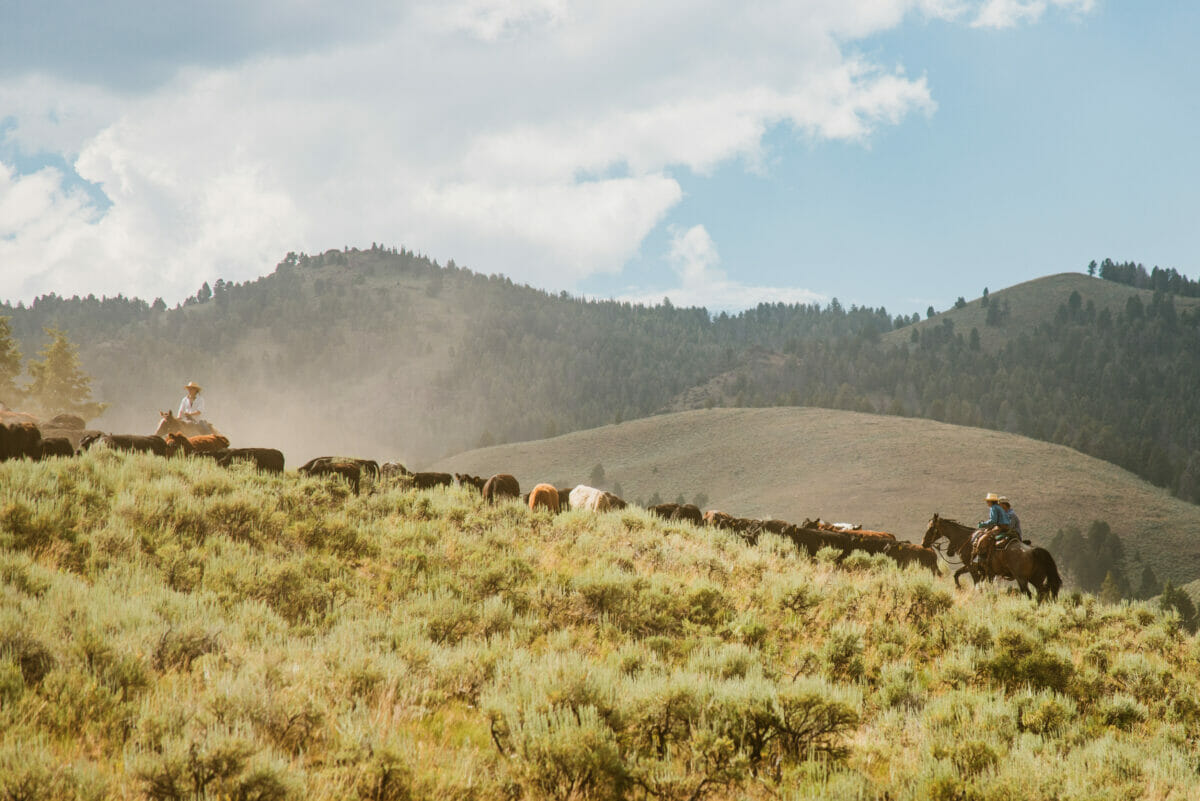
In the fall of 2014, when the Elzinga family of Alderspring Ranch were bringing their cattle back to the ranch from the jagged river canyons and rocky peaks of their public grazing allotment above Idaho’s Salmon River Corridor, they discovered 14 of their animals were missing.
Despite riding 30 to 50 miles on horseback four to five days a week to check on their herd, the Elzingas had lost $35,000 of revenue to predators.
Most of the signs pointed to wolves.
That year, biologists had documented 104 packs within the state as well as another 23 along its borders. U.S. Fish and Wildlife Service confirmed canids had killed 136 cattle and 114 sheep across the Northern Rocky Mountain states of Idaho, Montana and Wyoming.
Something had to change if Alderspring Ranch was going to stay in business. “We were licking our wounds,” says co-owner Glenn Elzinga, a forester by trade, who had been ranching for more than 20 years. “We came off that experience like we’re not going back—that’s economic suicide.”
Ever since the reintroduction of gray wolves in Yellowstone National Park nearly 30 years ago, ranchers across the West have been forced to find ways to protect their livestock from the apex predators. Many might prefer the three Ss (“shoot, shovel and shut up”). Others, such as the Elzingas, have found nonlethal methods for coexistence.

“As soon as the wolves knew we were there living with these cattle, that was the end of it,” said Glenn Elzinga. (Photo: Melanie Elzinga)
According to some estimates, upwards of two million wolves may have once roamed North America. But a federal extermination program in the US, aimed at helping white settlers protect livestock, brought them to the edge of extinction by the mid-20th century. With the rise of the environmental movement and the establishment of the Endangered Species Act in the 1970s, a two-decades-long journey toward restoring wolf populations in Yellowstone National Park and Central Idaho began. Studies in Yellowstone have shown that wolves have likely contributed to willow and aspen recovery, along with overall habitat diversity.
The issue of wolf recovery and reintroduction has been pitting rural landowners against urban wildlife advocates ever since, and it’s about to hit another milestone later this year.
Right now, the State of Colorado is working on a gray wolf reintroduction plan that passed a ballot measure in 2020. Those wolves, which are slated to be brought back to the state’s Western Slope this year, will be protected under state and federal laws (state lawmakers are currently trying to work out to what extent). This means Centennial State ranchers will be legally obligated to find nonlethal means of dealing with wolf predation. California, Washington and Oregon boast similar protections for wolves.
The techniques used by Alderspring Ranch could help.
Back to the range
A few months after lamenting their losses, Elzinga found himself at a neighbor’s house admiring an idyllic turn-of-the-century C.M. Russell painting of cowboys camping on the range with their cattle. The rancher had long been a fan of the cowboy artist’s work, but something about this particular image struck him. He got into his truck, turned to his wife Carol and asked, “Why can’t we just live on the range with our cattle like those guys did?”
Soon, Elzinga discovered a book entitled The Art & Science of Shepherding that explores the ancient techniques of French herders. It set him down a path toward what he now calls “inherding.” He and his crew, which includes his plant ecologist wife, seven daughters and handful of interns, stay with their cattle 24/7 for their entire summer grazing period.
Teams of at least three people go out for four-day stints, herding their 400 to 500 yearlings away from sensitive riparian areas and toxic plants and toward lush upland grasses. This helps to prevent erosion in critical streams that provide habitat for salmon and beavers while improving soil health and allowing native grasses to thrive. These cowpokes keep the entire herd huddled together on about 10 acres at a time to ensure the cattle are relaxed and grazing throughout the day, as they’re gently guided toward camp. Every night, the crew takes about 15 minutes to set up their 100-foot-by-100-foot night pens with a single strand of hotwire held up by fiberglass posts.
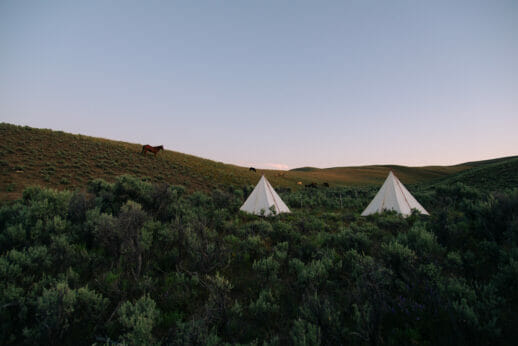
The Alderspring Ranch crew rides and camps with their cattle for the entire summer grazing period. (Photo: Melanie Elzinga)
Since it started the practice in 2015, Alderspring Ranch has not lost one animal to predation. “As soon as the wolves knew we were there living with these cattle, that was the end of it,” says Elzinga.
It sounds like a simple solution to the very complex and controversial problem of ranching among wolves; however, it’s far more difficult to implement than it may sound. Elzinga says most interns don’t start to understand the intricacies of herding, such as the subtle body cues of both animal and human, until nearly the 85th day of their 100-day internship. “This is a ton of work and it’s a ton of money—it comes at great costs,” he says.
No simple solution
These days, in addition to running cattle, most ranchers grow hay to keep their animals fed throughout the winter months. It’s a lot of work that is often done with few laborers, making it extremely difficult to spend nights out on the range.
That’s the model Don Gittleson follows at his 11,000-acre ranch near Walden, Colorado. During the week, while his wife is away, he tends to the animals and ranch by himself.
On the two consecutive nights of January 2022’s Wolf Full Moon, so-called in The Old Farmer’s Almanac due to the increase in howls around that time of year, a pack of eight wolves killed two of Gittleson’s cattle and injured another. They also injured one and killed another of his neighbor’s beloved—and very expensive—Border Collies.
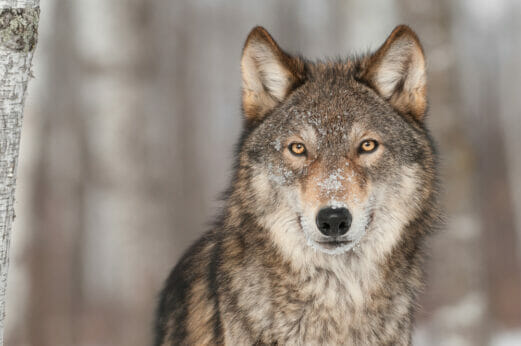
Wolves were brought them to the edge of extinction by the mid-20th century, but the population has rebounded thanks to reintroduction and conservation programs. (Photo: Shutterstock)
Gittleson tried everything the experts suggested.
He had people watch the pasture from their cars on the cold winter nights. Electrified fladry, a thin wire with hanging flags that flap in the breeze that has been used to scare wolves in Eastern Europe for centuries, worked for a while. When a section was removed to help his neighbor and was replaced with fox lights, a type of flashing predator deterrent, the wolves busted through and took down two newborn calves even with a human standing guard in the pasture. Gittleson himself chased off at least three wolves in his truck after they injured another calf.
Soon, the tension and lack of sleep began to impact Gittleson and his entire family. His wife’s heart problems and multiple sclerosis were exacerbated by the long nights. He struggled to work during the day. “The stress was actually a bigger deal than the dollar amount you lose on the cattle,” says Gittleson. “It takes a toll on you.”
Some pro-wolf and pro-wildlife nonprofits sent out volunteers and even paid watchers to keep an eye on the cattle at night. Many of those helpers, most of whom had little ranching experience, were more focused on trying to spot wolves than looking for signs of disturbance among the cattle. The wolves got more. “You don’t have the senses that animals have and, if you’re not paying attention, you’re not going to know what’s going on in the dark,” says Gittleson. “Cattle know when something is coming in.”
‘What does a cowboy know?’
Range riding, when done correctly, like Alderspring’s more intensive “inherding” technique, does work; however, it requires training and a deep understanding of animal behavior. It’s difficult to find people who do it right, yet the practice is growing and becoming more common across the West.
Alyssa Mahaney, who worked as a government trapper for the US Department of Agriculture Wildlife Services, did not lose a single cow during her eight years protecting herds from the notorious beef-loving Rogue Pack in Oregon’s Wood River Valley.
Mahaney lived in the woods for months on end, staying awake throughout the night. To make her presence known and deter wolves from coming near, she blasted music while driving around. Like Alderspring, she kept the cattle bunched together to keep them calm and make it harder for wolves to infiltrate the herd. A lifelong hunter who holds a Masters in Natural Resources Management, Mahaney likens range riding to a game of chess.
The problem with range riding, in her opinion, is that many of the people who choose to do it don’t understand the behavior and habits of predators and prey. “[Range riding] is a predator-dominated mindset,” says Mahaney. “You can’t just send a cowboy out there to deter wolves. What does a cowboy know? How to treat cows.”
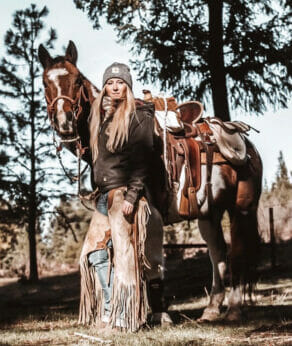
Alyssa Mahaney likens range riding to a game of chess. (Photo courtesy of Alyssa Mahaney)
Due to time and terrain constraints, most ranchers check on their cattle every few days or, in some cases, just once a week. That doesn’t work when wolves are around.
The goal, says Carter Niemeyer, a retired federal wolf recovery coordinator for the U.S. Fish and Wildlife Service, should be to prevent an attack before it happens. Once wolves get habituated to the taste of beef, it becomes far harder to stop them from picking off cattle. “When you look at the number of wolves in the western population, most are behaving themselves,” he says. “Once the wolves start to kill cattle, agencies react and ranchers try to play catch up.”
The number of verified livestock killings by wolves is relatively low when you compare it to the number of livestock out on the range. In Montana, which boasted 1,144 wolves in 2021, there have been less than 100 verified wolf depredation incidents per year since 2009, according to a Montana Fish, Wildlife & Parks report. As of January of this year, the state boasted 2.16 million head of cattle. Still, that equals roughly one dead farm animal per 11 wolves every year.
The top predator in the state is the coyote. And even livestock killings by coyotes have decreased dramatically over recent years as the state has increased grants to help prevent depredation. In 2022, it was confirmed that predators killed 196 farm animals, compared to 313 the prior year.
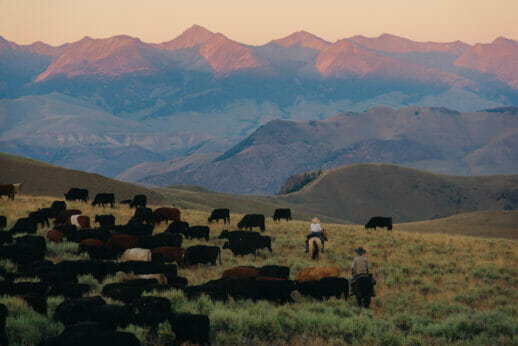
Range riding requires training and an understanding of animal behavior. (Photo: Melanie Elzinga)
A larger-than-life presence
In spite of the statistics, wolves elicit far stronger emotions than any other predator in the West. Part of that stems from the fact that the resurgence of wolf numbers is a relatively new phenomenon, and it’s one with which today’s ranchers aren’t accustomed to dealing. Although many Indigenous American tribes imbued wolves with powerful positive attributes, depictions in the folklore of agrarian Eurocentric societies tend toward the “big bad wolf” trope of malicious and cunning creatures that terrorize humans. Some ranchers invoke the image of wolves killing for sport, called “surplus killing.” Biologists say that, if left alone, wolves eventually return to eat their catch.
But for the ranchers who spoke to Modern Farmer, there’s also a deep respect for the creatures. Mahaney, who admits she has a strong disregard for wolves, says, “The first time I ever heard a wolf pack sound off and respond to my howls was the most primal, spiritual feeling I’ve ever felt.”

Wolf, coyote, and bobcat tracks in the snow. (Photo courtesy of Alyssa Mahaney)
Elzinga, in spite of his previous losses, admires the estimated 1,300 wolves that surround his land. He feels like there’s a sort of mutual respect between him and them. They’ve forced him to change his methods, which has had a hugely beneficial impact to the ecosystem, as well as his bottom line. Because of his low-stress livestock handling and intensive grazing management, Elzinga estimates that he’s earning an extra $2 a day in weight gain, increasing his herd’s value by about $100,000 per grazing season. “Inherding wasn’t only a win with wolves, where you’re stopping the loss of cash [from dead animals]; it can also be a gain of cash,” he says.
Yet, Elzinga is always aware that wolves will act according to their nature. “If we give them an opportunity to behave badly, they might.”
Inspiring. Shows that workìng with Nature pays off. Guardian dogs can help. They bond with the cattle or sheep and protect “thier” family. Thier senses and instincts are superior to us humans.
I wish ranchers would use these dogs; all ranchers with cattle on open range, not just the more open-minded ones. Would like to see it conditional on obtaining public land grazing leases. So often the ranchers and sheep herders in Europe are ahead of U.S. Would be curious in knowing the impact on total cattle loss over a season.
https://www.aphis.usda.gov/aphis/ourfocus/wildlifedamage/sa_operational_activities/sa_dogs/#:~:text=LPD%20breeds%20originated%20in%20Europe,fawn%20colored%20with%20dark%20muzzles.
This will probably be deleted because you don’t want the people of Colorado to know the truth. I will check back on it. The same reason is that you do not keep the reviews about the Colorado Parks and Wildlife, unless they are good. All I can say is the freedom of speech set by our forefathers was provided because they needed it as we need it now to protect our Wildlife resources against the Colorado Parks and Wildlife. Wolf Re-introduction Ignorance by the Colorado Parks and Wildlife. Only when people are stupid, does the Colorado Parks and wildlife becomes… Read more »
Just kill the wolves. Reintroducing them was the stupidest idea ever.